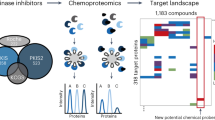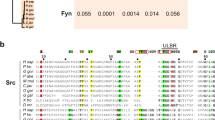Abstract
Protein kinases, key regulators of intracellular signal transduction, have emerged as an important class of drug targets. Chemical proteomic tools that facilitate the functional interrogation of protein kinase active sites are powerful reagents for studying the regulation of this large enzyme family and performing inhibitor selectivity screens. Here we describe a new crosslinking strategy that enables rapid and quantitative profiling of protein kinase active sites in lysates and live cells. Applying this methodology to the SRC-family kinases (SFKs) SRC and HCK led to the identification of a series of conformation-specific, ATP-competitive inhibitors that have a distinct preference for the autoinhibited forms of these kinases. Furthermore, we show that ligands that have this selectivity are able to modulate the ability of the regulatory domains of SRC and HCK to engage in intermolecular binding interactions. These studies provide insight into the regulation of this important family of tyrosine kinases.
This is a preview of subscription content, access via your institution
Access options
Subscribe to this journal
Receive 12 print issues and online access
$259.00 per year
only $21.58 per issue
Buy this article
- Purchase on Springer Link
- Instant access to full article PDF
Prices may be subject to local taxes which are calculated during checkout






Similar content being viewed by others
Accession codes
References
Manning, G., Whyte, D.B., Martinez, R., Hunter, T. & Sudarsanam, S. The protein kinase complement of the human genome. Science 298, 1912–1934 (2002).
Cohen, P. Protein kinases—the major drug targets of the twenty-first century? Nat. Rev. Drug Discov. 1, 309–315 (2002).
Zhang, J., Yang, P.L. & Gray, N.S. Targeting cancer with small molecule kinase inhibitors. Nat. Rev. Cancer 9, 28–39 (2009).
Cravatt, B.F., Wright, A.T. & Kozarich, J.W. Activity-based protein profiling: from enzyme chemistry to proteomic chemistry. Annu. Rev. Biochem. 77, 383–414 (2008).
Barglow, K.T. & Cravatt, B.F. Activity-based protein profiling for the functional annotation of enzymes. Nat. Methods 4, 822–827 (2007).
Simon, G.M. & Cravatt, B.F. Activity-based proteomics of enzyme superfamilies: serine hydrolases as a case study. J. Biol. Chem. 285, 11051–11055 (2010).
Bantscheff, M. et al. Quantitative chemical proteomics reveals mechanisms of action of clinical ABL kinase inhibitors. Nat. Biotechnol. 25, 1035–1044 (2007).
Patricelli, M.P. et al. In situ kinase profiling reveals functionally relevant properties of native kinases. Chem. Biol. 18, 699–710 (2011).
Sharma, K. et al. Proteomics strategy for quantitative protein interaction profiling in cell extracts. Nat. Methods 6, 741–744 (2009).
Cheng, H.C. et al. Allosteric networks governing regulation and catalysis of Src-family protein tyrosine kinases: implications for disease-associated kinases. Clin. Exp. Pharmacol. Physiol. 37, 93–101 (2010).
Kim, L.C., Song, L. & Haura, E.B. Src kinases as therapeutic targets for cancer. Nat. Rev. Clin. Oncol. 6, 587–595 (2009).
Huse, M. & Kuriyan, J. The conformational plasticity of protein kinases. Cell 109, 275–282 (2002).
Boggon, T.J. & Eck, M.J. Structure and regulation of Src family kinases. Oncogene 23, 7918–7927 (2004).
Karaman, M.W. et al. A quantitative analysis of kinase inhibitor selectivity. Nat. Biotechnol. 26, 127–132 (2008).
Hantschel, O., Rix, U. & Superti-Furga, G. Target spectrum of the BCR-ABL inhibitors imatinib, nilotinib and dasatinib. Leuk. Lymphoma 49, 615–619 (2008).
Li, J. et al. A chemical and phosphoproteomic characterization of dasatinib action in lung cancer. Nat. Chem. Biol. 6, 291–299 (2010).
Shi, H., Zhang, C.J., Chen, G.Y. & Yao, S.Q. Cell-based proteome profiling of potential dasatinib targets by use of affinity-based probes. J. Am. Chem. Soc. 134, 3001–3014 (2012).
Getlik, M. et al. Hybrid compound design to overcome the gatekeeper T338M mutation in cSrc. J. Med. Chem. 52, 3915–3926 (2009).
Best, M.D. Click chemistry and bioorthogonal reactions: unprecedented selectivity in the labeling of biological molecules. Biochemistry 48, 6571–6584 (2009).
Los, G.V. et al. HaloTag: a novel protein labeling technology for cell imaging and protein analysis. ACS Chem. Biol. 3, 373–382 (2008).
Jura, N. et al. Catalytic control in the EGF receptor and its connection to general kinase regulatory mechanisms. Mol. Cell 42, 9–22 (2011).
Engen, J.R. et al. Structure and dynamic regulation of Src-family kinases. Cell. Mol. Life Sci. 65, 3058–3073 (2008).
Briggs, S.D. & Smithgall, T.E. SH2-kinase linker mutations release Hck tyrosine kinase and transforming activities in Rat-2 fibroblasts. J. Biol. Chem. 274, 26579–26583 (1999).
Gonfloni, S., Frischknecht, F., Way, M. & Superti-Furga, G. Leucine 255 of Src couples intramolecular interactions to inhibition of catalysis. Nat. Struct. Biol. 6, 760–764 (1999).
Osusky, M., Taylor, S.J. & Shalloway, D. Autophosphorylation of purified c-Src at its primary negative regulation site. J. Biol. Chem. 270, 25729–25732 (1995).
Lerner, E.C. et al. Activation of the Src family kinase Hck without SH3-linker release. J. Biol. Chem. 280, 40832–40837 (2005).
Alvarado, J.J., Betts, L., Moroco, J.A., Smithgall, T.E. & Yeh, J.I. Crystal structure of the Src family kinase Hck SH3–SH2 linker regulatory region supports an SH3-dominant activation mechanism. J. Biol. Chem. 285, 35455–35461 (2010).
Ayrapetov, M.K. et al. Conformational basis for SH2-Tyr(P)527 binding in Src inactivation. J. Biol. Chem. 281, 23776–23784 (2006).
Lerner, E.C. & Smithgall, T.E. SH3-dependent stimulation of Src-family kinase autophosphorylation without tail release from the SH2 domain in vivo. Nat. Struct. Biol. 9, 365–369 (2002).
Moarefi, I. et al. Activation of the Src-family tyrosine kinase Hck by SH3 domain displacement. Nature 385, 650–653 (1997).
Wodicka, L.M. et al. Activation state–dependent binding of small molecule kinase inhibitors: structural insights from biochemistry. Chem. Biol. 17, 1241–1249 (2010).
Georghiou, G., Kleiner, R.E., Pulkoski-Gross, M., Liu, D.R. & Seeliger, M.A. Highly specific, bisubstrate-competitive Src inhibitors from DNA-templated macrocycles. Nat. Chem. Biol. 8, 366–374 (2012).
Sicheri, F., Moarefi, I. & Kuriyan, J. Crystal structure of the Src family tyrosine kinase Hck. Nature 385, 602–609 (1997).
Xu, W., Harrison, S.C. & Eck, M.J. Three-dimensional structure of the tyrosine kinase c-Src. Nature 385, 595–602 (1997).
Schindler, T. et al. Structural mechanism for STI-571 inhibition of abelson tyrosine kinase. Science 289, 1938–1942 (2000).
Seeliger, M.A. et al. Equally potent inhibition of c-Src and Abl by compounds that recognize inactive kinase conformations. Cancer Res. 69, 2384–2392 (2009).
Dar, A.C., Lopez, M.S. & Shokat, K.M. Small molecule recognition of c-Src via the Imatinib-binding conformation. Chem. Biol. 15, 1015–1022 (2008).
Simard, J.R. et al. A new screening assay for allosteric inhibitors of cSrc. Nat. Chem. Biol. 5, 394–396 (2009).
Wood, E.R. et al. A unique structure for epidermal growth factor receptor bound to GW572016 (Lapatinib): relationships among protein conformation, inhibitor off-rate, and receptor activity in tumor cells. Cancer Res. 64, 6652–6659 (2004).
Marcotte, D.J. et al. Structures of human Bruton′s tyrosine kinase in active and inactive conformations suggest a mechanism of activation for TEC family kinases. Protein Sci. 19, 429–439 (2010).
Okuzumi, T. et al. Inhibitor hijacking of Akt activation. Nat. Chem. Biol. 5, 484–493 (2009).
Poulikakos, P.I., Zhang, C., Bollag, G., Shokat, K.M. & Rosen, N. RAF inhibitors transactivate RAF dimers and ERK signalling in cells with wild-type BRAF. Nature 464, 427–430 (2010).
Hatzivassiliou, G. et al. RAF inhibitors prime wild-type RAF to activate the MAPK pathway and enhance growth. Nature 464, 431–435 (2010).
Rauch, J., Volinsky, N., Romano, D. & Kolch, W. The secret life of kinases: functions beyond catalysis. Cell Commun. Signal. 9, 23 (2011).
Kaplan, K.B., Swedlow, J.R., Morgan, D.O. & Varmus, H.E. c-Src enhances the spreading of src−/− fibroblasts on fibronectin by a kinase-independent mechanism. Genes Dev. 9, 1505–1517 (1995).
García-Martínez, J.M. et al. A non-catalytic function of the Src family tyrosine kinases controls prolactin-induced Jak2 signaling. Cell. Signal. 22, 415–426 (2010).
Katsuta, H., Tsuji, S., Niho, Y., Kurosaki, T. & Kitamura, D. Lyn-mediated down-regulation of B cell antigen receptor signaling: inhibition of protein kinase C activation by Lyn in a kinase-independent fashion. J. Immunol. 160, 1547–1551 (1998).
Xu, H. & Littman, D.R. A kinase-independent function of Lck in potentiating antigen-specific T cell activation. Cell 74, 633–643 (1993).
Boudeau, J., Miranda-Saavedra, D., Barton, G.J. & Alessi, D.R. Emerging roles of pseudokinases. Trends Cell Biol. 16, 443–452 (2006).
Seeliger, M.A. et al. High yield bacterial expression of active c-Abl and c-Src tyrosine kinases. Protein Sci. 14, 3135–3139 (2005).
Acknowledgements
Several ATP-competitive inhibitors were provided by R. Murphy (University of Washington, Seattle) and G. Perera (University of Washington, Seattle). This research was supported by US National Institutes of Health grants R01GM086858 (D.J.M.) and R01AI089441 (E.A.M.) and the Alfred P. Sloan Foundation (D.J.M.).
Author information
Authors and Affiliations
Contributions
R.K. and D.J.M. conceived the idea and designed the study. R.K. conducted crosslinking experiments. R.K. and S.E.L. performed biochemical studies with SFK variants. R.K. and E.J.D. synthesized compounds. J.L.B. designed, expressed and purified HaloTag fusion constructs. P.R. constructed, expressed and purified SFK variants. E.T.L. and E.A.M. carried out crystallographic studies. R.K. and D.J.M. wrote the paper.
Corresponding author
Ethics declarations
Competing interests
The authors declare no competing financial interests.
Supplementary information
Supplementary Text and Figures
Supplementary Results and Supplementary Methods (PDF 7446 kb)
Rights and permissions
About this article
Cite this article
Krishnamurty, R., Brigham, J., Leonard, S. et al. Active site profiling reveals coupling between domains in SRC-family kinases. Nat Chem Biol 9, 43–50 (2013). https://doi.org/10.1038/nchembio.1118
Received:
Accepted:
Published:
Issue Date:
DOI: https://doi.org/10.1038/nchembio.1118
This article is cited by
-
In situ imaging and proteome profiling indicate andrographolide is a highly promiscuous compound
Scientific Reports (2015)
-
Multiplex Imaging and Cellular Target Identification of Kinase Inhibitors via an Affinity-Based Proteome Profiling Approach
Scientific Reports (2015)
-
Affinity purification in target identification: the specificity challenge
Archives of Pharmacal Research (2015)



